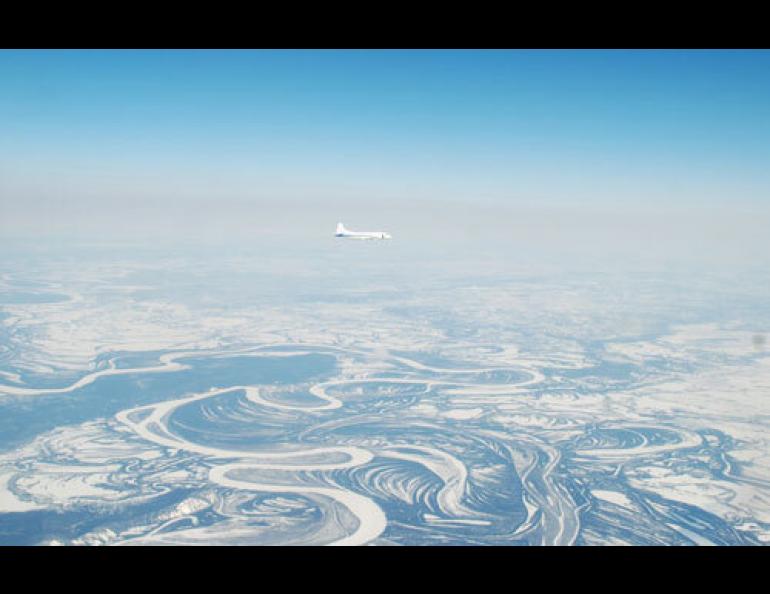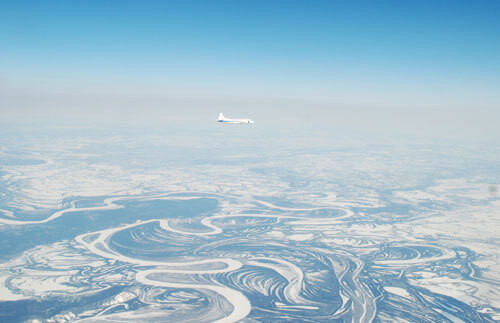
Springtime smoke in Siberia is our arctic haze
Arctic haze is a blob of air pollution that sloshes over the northern cap of the planet in springtime. It’s visible as a murkiness that prevents you from seeing Denali, or as dark bands on the horizon from the windows of planes flying over northern Alaska. On a bad day, it can make Alaska look like Los Angeles or Denver.
In the 1970s, scientists studied the northern air and found sulfur and black carbon floating in it from dirty smelters in Russia and other areas in Eurasia. Last spring, a team of scientists from Colorado took six flights north from Fairbanks in a plane designed to sniff the air and collect samples. After analyzing air from above northern Alaska and the sea ice north of Barrow, team members have concluded what much of the dark stuff was. It was soot from forest fires in southern Siberia and Lake Baikal, and from farmers preparing their fields by burning stubble in Kazakhstan and southern Russia.
“The fire plumes were a big surprise,” said Chuck Brock of National Oceanic and Atmospheric Administration’s Earth System Research Laboratory in Boulder, Colorado. “We don’t think of forest fires being a factor until later in the season.”
April does seem a bit early for forest fires in the north, but Brock said many of them might have been started as a result of agricultural fires that got out of control and spread to the boreal forest.
So, northern residents are probably breathing molecules of vaporized black spruce trees and wheat stems from across the Bering Strait, and it might be a yearly event, Brock said. The team at the NOAA research lab is trying to determine if spring 2008’s event was typical of foul air that visits northern Alaska every year.
As for the lack of industrial pollutants that researchers usually expect with arctic haze, Brock said that soup of nasty chemicals was still there, but the fire smoke dominated the weaker signal.
“It’s like how in L.A. you can’t see (arctic haze chemicals) because you’re swamped by other pollution,” Brock said.
Glenn Shaw, a professor emeritus at the Geophysical Institute who has performed pioneering studies on arctic haze, wasn’t surprised the smoke overpowered the industrial signal in the northern air samples.
“Arctic haze consists of rather small amounts of pollution, but it’s spread over large areas,” Shaw said.
A nice feature about arctic haze is that it doesn’t endure the entire year. The washing machine of nature is now cranking up. The returning sun is generating winds that bust up the large parcel of stagnant air that has “been stewing around there for a long time,” Brock said.
***
The founders of the Pacific Tsunami Museum located in Hilo, Hawaii, will travel to Alaska this summer to interview survivors of the waves generated by the 1964 earthquake. Walter Dudley of the University of Hawaii at Hilo and Jeanne Branch Johnston will travel to Alaska in June, to Seward and Valdez among other stops. They are interested in interviewing individuals with first-hand knowledge about the 1964 event as well as those with information regarding indigenous knowledge regarding tsunamis in Alaska.
Jeanne Branch Johnston, the interviewer, is a survivor of the 1946 Alaska-generated tsunami that took 159 lives in Hawaii.
“I am well aware of the pain and trauma inflicted upon the survivors that, in some cases, never really goes away—at the very least, it impacts your life forever,” she said.
The interviews will be archived at the Pacific Tsunami Museum and the Valdez Museum for educational, research and historical purposes. If you are willing to be interviewed, contact Jeanne Branch Johnston at tsunamigal1946@hotmail.com.



